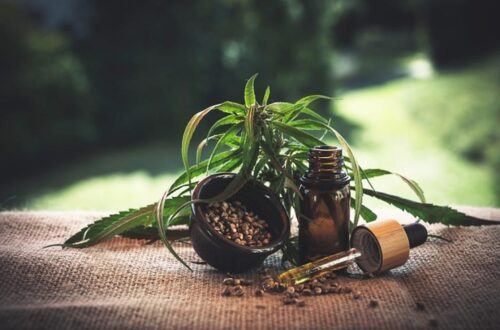Cannabinoids often steal the spotlight when it comes to the benefits and indulgence of cannabis, but what about their acidic versions? That’s right, we’re diving into the world of acidic cannabinoids like THCA, CBDA, and CBGA.
These compounds are the unsung heroes, acting as the raw, untouched forms of their more famous counterparts. They offer a fascinating glimpse into the cannabis plant’s potential long before the decarboxylation process takes place.
In this guide, you’ll discover how THCA, CBDA, and CBGA differ from THC, CBD, and CBG. Plus, we’ll explore their unique properties, benefits, and how you can incorporate them into your wellness routine. Get ready to unlock a new dimension of understanding in the dynamic world of cannabis!
Understanding the Basics of THCA, CBDA, and CBGA
Acidic cannabinoids start their journey in raw cannabis, existing in their natural, unheated state. THCA (tetrahydrocannabinolic acid), CBDA (cannabidiolic acid), and CBGA (cannabigerolic acid) are the foundation blocks of some of the most well-known cannabinoids.
THCA: The Precursor to THC
THCA is the precursor to THC, the compound famous for its psychoactive effects. When cannabis is heated or aged, THCA converts to THC. Despite being non-psychoactive, THCA holds promise for various wellness benefits, including anti-inflammatory and neuroprotective properties.
CBDA: The Raw Form of CBD
Similarly, CBDA is the acidic version of CBD. Found in raw, unprocessed cannabis, CBDA transforms into CBD through the decarboxylation process. Research suggests that CBDA might help with conditions like nausea and inflammation, making it a compound worth exploring.
CBGA: The Mother of All Cannabinoids
CBGA, often referred to as the “mother of all cannabinoids,” is crucial as it serves as the precursor to both THCA and CBDA. Without CBGA, the other cannabinoids wouldn’t exist. CBGA itself is being studied for potential benefits, including antibacterial and anti-inflammatory effects.
These acidic cannabinoids offer a treasure trove of potential, making them an exciting area of study and use for both novice and seasoned cannabis enthusiasts alike.
The Role of Acidic Cannabinoids in Cannabis
Acidic cannabinoids play a pivotal role in the cannabis plant’s lifecycle. Starting from their raw, natural forms, these compounds help the plant thrive and ward off pests.
Their Function in Plant Health
In the wild, acidic cannabinoids act as a defense mechanism. THCA, CBDA, and CBGA protect the cannabis plant from harmful UV rays and diseases. They also deter insects and other herbivores, ensuring the plant’s longevity and ability to reproduce.
Potential Human Benefits
As we dive deeper into research, it becomes evident that these compounds have significant potential for human health too. Unlike their decarboxylated counterparts, acidic cannabinoids like THCA and CBDA are non-psychoactive, opening doors for those who seek the therapeutic benefits of cannabis without the high.
Acidic cannabinoids are believed to offer anti-inflammatory, anti-nausea, and neuroprotective properties. Ongoing studies are constantly uncovering new potential applications, making them a hot topic in the world of cannabis research.
Simply put, acidic cannabinoids are not just crucial for cannabis plants, but they might also hold the key to many wellness breakthroughs for us humans.
Benefits and Potential Uses of THCA, CBDA, and CBGA
THCA, CBDA, and CBGA are gaining attention for their unique health benefits. Unlike the more well-known THC and CBD, these acidic cannabinoids offer distinct therapeutic properties without inducing a high.
THCA, or tetrahydrocannabinolic acid, is known for its anti-inflammatory effects. It’s being studied for its potential to alleviate pain and swelling associated with conditions like arthritis. Additionally, it may help in managing nausea and appetite loss, making it a promising option for patients undergoing chemotherapy.
CBDA, or cannabidiolic acid, stands out for its anti-nausea properties. It’s particularly effective in reducing nausea and vomiting, which can benefit those dealing with chronic illnesses or severe treatments. Research also suggests that CBDA has powerful anti-anxiety effects, offering a natural way to alleviate stress and anxiety.
CBGA, or cannabigerolic acid, is often referred to as the “mother of all cannabinoids.” It serves as the precursor to THCA, CBDA, and other cannabinoids. CBGA has shown potential in reducing inflammation and combating bacterial infections. It’s also being researched for its ability to protect brain cells, which could be crucial in treating neurodegenerative diseases.
Incorporating these acidic cannabinoids into your wellness routine might offer new avenues for relief and health improvement. As research continues, we can look forward to uncovering even more benefits.
How to Incorporate Acidic Cannabinoids into Your Daily Routine
Getting started with THCA, CBDA, and CBGA is simpler than it might seem! One of the easiest ways is through raw cannabis or hemp juice. Juicing the fresh leaves and flowers preserves these beneficial compounds and offers a potent health boost.
If juicing isn’t your thing, there are other options. Tinctures and oils specifically formulated to keep these cannabinoids in their acidic form are available. You can add a few drops to your morning smoothie, coffee, or even directly under your tongue for a quick and efficient intake.
For a more culinary approach, consider incorporating raw cannabis or hemp into your salads or other cold dishes. This method ensures that the cannabinoids remain in their pre-decarboxylated state, maintaining their unique properties.
Another convenient option is to use topical products infused with THCA, CBDA, or CBGA. These come in creams, balms, and oils that you can apply directly to your skin, targeting localized inflammation and pain.
Lastly, capsules and edibles are becoming more popular. These products offer a pre-measured dose, making it easy to integrate into your daily supplement routine without any fuss.
With all these choices, it’s easy to find a method that fits seamlessly into your lifestyle. The key is consistency—the more regularly you incorporate these cannabinoids, the more potential benefits you’ll likely see.
The Bottom Line: Maximizing the Potential of Acidic Cannabinoids
Incorporating acidic cannabinoids like THCA, CBDA, and CBGA into your routine might seem a little overwhelming at first, but it’s actually quite simple with the right approach. These compounds offer promising health benefits, from anti-inflammatory properties to neuroprotective effects, making them a valuable addition to your wellness toolkit.
Remember, the key to maximizing their potential lies in consistency and proper intake methods. Whether you choose juices, tinctures, raw dishes, topicals, or capsules, there’s a method out there that can seamlessly fit into your lifestyle.
It’s essential to keep these cannabinoids in their raw form to fully benefit from their unique properties. Fresh, uncooked methods are the way to go if you want to maintain their effectiveness.
Small daily steps can lead to significant positive changes over time. Start with a method that feels right for you and gradually incorporate it into your routine. Pay attention to how your body responds and adjust as necessary.
In a world where wellness trends come and go, acidic cannabinoids offer a scientifically backed, natural means to support your health. With minimal side effects and a growing body of research supporting their benefits, they represent a feasible option for those seeking holistic health solutions.
So, whether you’re looking to enhance your diet, manage specific health issues, or simply explore something new, giving these compounds a try could be a game-changer. Here’s to discovering the untapped potential of acidic cannabinoids and reaping the benefits they have to offer!






